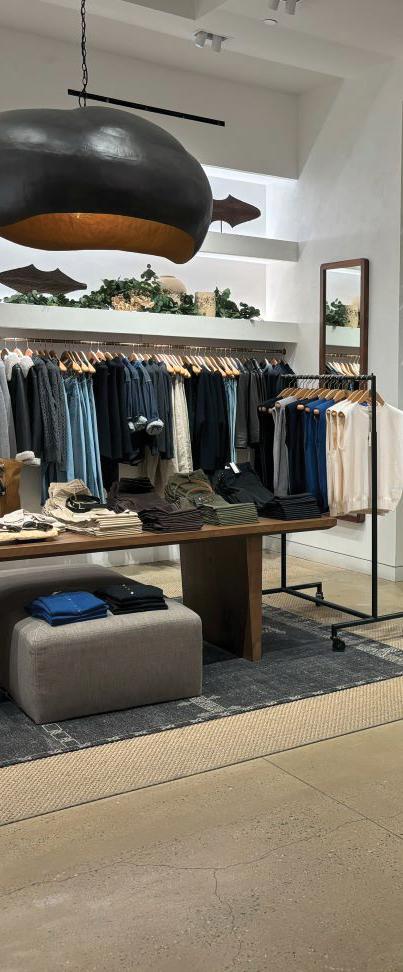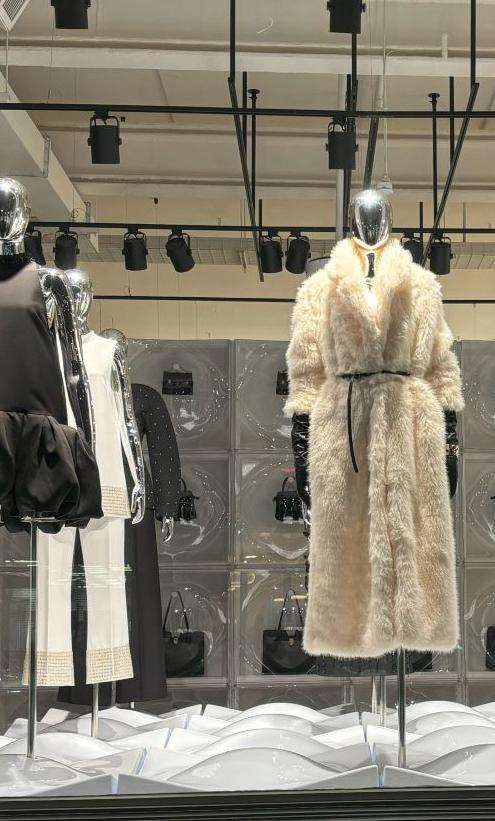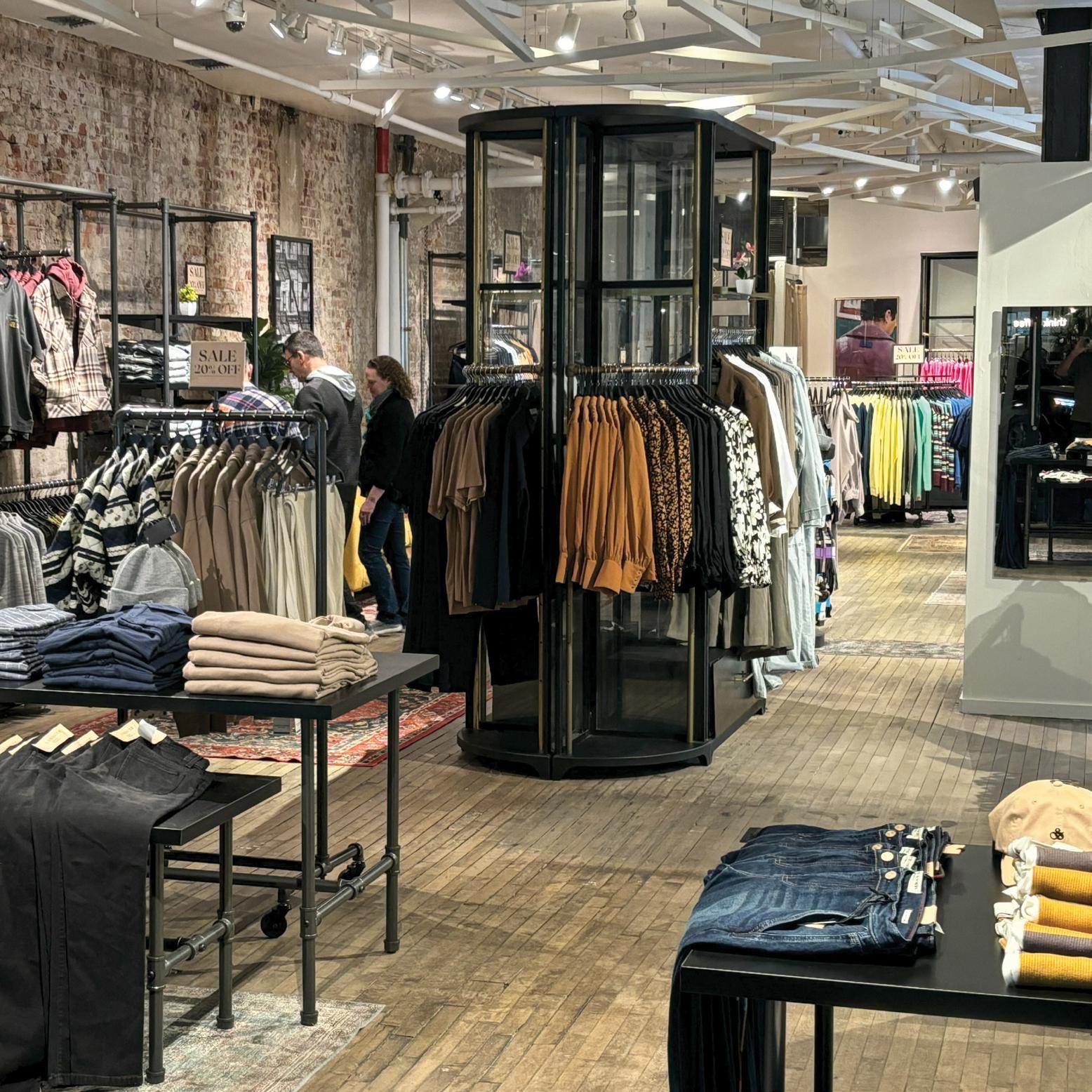

New Stores in New York
A Guide for Retailers


Stores worth visiting while in New York during NRF 2025
Brought to you by John Ryan
With the exception of the cover and Wegmans images, the images featured in this guide were photographed by John Ryan
On the cover: Dyson // Mercer Street, SoHo
Pictured left: Banana Republic // 556 Broadway, SoHo
NYC: A Market in Transition
A lot has happened over the last 12 months in the Big Apple, the majority of it in Lower Manhattan’s SoHo as refurbishments complete and retailers move back into premises they had left while they were being given a makeover.
Technology, in the shape of screens, for the most part, is a given, but there is an increasing emphasis on lighting with some stores now best viewed at night. There is also a tendency for retailers to open small(er) stores as they strive to become more ‘local’ and relevant to particular districts, rather than operating from the few relatively big boxes that may occasionally become available in New York City.
Amazon continues to play with palm payment tech with the new Whole Foods Market Daily Shop on the Upper East Side showing how it is taking its efforts into eponymous Whole Food Market stores. Also worth noting is the fact that for a nation wedded to the idea of staff being on hand to pack groceries at the checkout, most new stores now rely upon selfcheckout (SCO) and leave packing and bagging to
the shopper. To some extent, the US has been behind the curve with SCO, but it is catching up with every new store opening/refurbishment.
As elsewhere, SCO and the various methods used mean pluses and minuses. GU, which is in many ways an entry level Uniqlo, has just entered the market and like its big sister it uses the throw everything in an open-topped box and let the RFID tags do the scanning job. All good, but there are security implications and not everybody knows how to use it. By contrast, Manhattan food retailers rely on shopper scanning (or none at all in Traders Joes, which remains perhaps NYC’s most beautiful grocery interior) to get the SCO job done, Wegmans is a prime example, possibly more time-consuming, but almost certainly more secure and more readily controlled.
New York’s retail scene is changing with a combination of tech and big format retailers arriving in the city, making this a market that is increasingly becoming more like the rest of the US in terms of familiar names, but better overall.






Food and Payment
Pictured left: Morton Williams // 1251 Third Avenue (corner of 72nd St)
Whole Foods Market Daily Shop
1175 Third Avenue, opened in September

At 9,101 sq ft, this single floor store is considerably smaller than other Whole Foods Market branches around the city and the retailer claims not only that this is a convenience store, but also that it is its first small format store. This may be the case, yet by convenience store standards, it is relatively large and it boasts 10 SCOs and no manned checkouts, although items can be bought at the adjacent “Customer Service” desk. Those wishing to do so can pay by palm, provided they have previously allowed their data to be captured.
The store is sufficiently large to allow a ‘big shop’ to take place, but the size of the SCOs implies that this is a store that is about ‘little and often’. Located close to a subway station on the Upper East Side, this will also work for locals picking something up (pre-ordering by phone is possible) on their way home.
Whole Foods Market may be owned by Amazon, but Amazon online order returns are not allowed in this branch, and the heavy emphasis on ‘fresh’ means buy and cook, rather than buy and keep for another day.


Morton Williams
1251 Third Avenue (corner of 72nd St)


Convenience and limited SCO

Open since 2018, but worth looking at as it is very close to the new Whole Foods Market Daily Shop and serves the same customer. It is therefore the competition for the incoming operation. This is a branch of a 15-strong familyowned chain of grocery stores and like the Whole Foods store, it has the feeling of being where deli meets supermarket.
It also uses SCO as its principal method of payment and has graphics around the store emphasising that this is a ‘curated’ offer (meaning that the range is smaller than in other Morton Williams branches).
The proposition is fresh and prepared foods and meals. A blacked-out ceiling and pendant light installation complete the message that this is a store for well-off Upper East Siders who need a local food store.
Wegmans
Astor Place
Majoring on SCO and with eye-catching visual merchandising
Having recently celebrated its first birthday and with another Manhattan branch on the way, North-Eastern favourite Wegmans has some of the most-used SCOs in the city and it also happens to be one of the best-looking stores in terms of grocery visual merchandising, ambience, and freshness (alongside its Brooklyn branch).
This is the real competition for Whole Foods Market and if the grocer makes good on an Uptown branch in a former Bed Bath & Beyond, it seems likely there may be a mild price war for the custom of Manhattan’s well-heeled locals.
This may seem like last year’s big thing, but it remains a must-see for anyone interested in food retail who is passing through.






Fashion
Pictured left: GU // 578 Broadway, SoHo
Banana Republic
556 Broadway, SoHo
Clothing and homewares mingle
A store that moved across the road while it was being refurbished is now back in the building that it calls home and “home” is what a lot of this store is about, despite this being a fashion retailer.
This is perhaps for those who visit RH in Tribeca but find the prices off-putting and want something slightly more accessible.
As when it was in its ‘pop-up’ premises directly across Broadway, this store is about taking fashion and mixing it with homewares with the latter being used as a series of room sets in which there just happens to be Banana Republic clothes.
The store may be about clothing, but it has the feel of a well-heeled SoHo apartment of the kind found across this part of Lower Manhattan. Tech is in place, of course, but Banana Republic in SoHo is mostly about personal service.







GU
578 Broadway, SoHo
Fast Retailing’s bargain basement Uniqlo, RFID SCO
From Fast Retailing comes Gu, the first of its kind outside East Asia (and more specifically, Japan). This is a store which is different in terms of graphics and the many digital totems that are suspended above shoppers in this two-floor (ground and basement) store.
Yet if the signage were removed, this would be Uniqlo, but a bit cheaper, right down to the RFIDdriven SCOs, meaning shoppers do not have to scan anything at the checkout – they just drop their purchases into an open-topped box next to the terminal and the machines do the rest.
In terms of display, this is Uniqlo, but the range is more limited (meaning greater volume per SKU and therefore lower prices) with the visual merchandising being very similar. Busy since it opened in September, this is a permanent store that follows a pop-up that traded in the same area.
591 Broadway, SoHo


H&M for women in which large formant screens star
This is a refurbished store and a flagship for lower Manhattan. Worth noting above everything else are the pair of screens, on opposite walls about halfway into the store.
Like the use made by Inditex of big screens across all of its brands, this is about drawing shoppers through the space and with moving content giving a degree of dynamism to the interior.
The store is unusual in that it is a single gender H&M offering solely women’s clothing. Its location means that it has a lot of competition, from Uniqlo and GU, to Zara and Brandy Melville, a little further down Broadway. The offer is more ‘city’ and tailored than in other H&M stores around Manhattan.

Scotch & Soda
591 Broadway, SoHo
The return of a Dutch fashion brand to lower Manhattan
A return to NYC for the Dutch fashion brand that went into receivership in April 2023, to be rescued, in smaller form, by New York-based brand management company Bluestar Alliance.
The store is 6,000 sq ft, making it slightly bigger than other US Scotch & Soda stores, and is a thing of natural hardwood flooring, distressed brick walls and industrial-inspired metal fixtures, in keeping with SoHo and its industrial feel.
Once again, this is another cross-border outfit that is trying to act like a fashionable indie, but which has the backing of an international outfit.



General Merchandise
Pictured left: Dyson // Mercer Street, SoHo




Dyson
Mercer Street, SoHo
A second Manhattan flagship, screens & hero displays
This is the British electronics brand and retailer’s second outpost in Manhattan and in look and feel it is a considerable move on from the store that opened on Fifth Avenue in 2018.
The store is, generally, about hairdryers, vacuum cleaners and headphones (with a few fans and air purifiers thrown in for good measure) and each category is displayed in a darkened setting with hero lighting used to ensure that nothing is missed and to promote the idea of a lit stage.
At the back of the store another large screen is used to draw the eye through the space, while for those who have the time, there is a blow-dry salon upstairs, not immediately visible thanks to banks of dark glass.
Dark glass also forms the store exterior, giving this branch a sleek, high-tech feel that is somewhat at odds with the SoHo norm.
James Dyson paid $60m for this building in 2023. The products are the same as on Fifth Avenue, the store is not.
So, what does this all mean?
1. Screens are more targeted and tending to be larger – being used to draw shoppers’ gazes through a store. Moving content is more common than static.
2. Self-checkouts are rapidly becoming the fashion norm in the mid-market. The US has been slow to adopt SCO, particularly in food retail, as service and bagging have long been the norm.
3. Large format retailers continue to open small stores in an attempt to become more ‘local’.
4. In general, retailers are increasingly opening physical stores in NYC with shoppers being inclined to shop, rather than going online.
5. Autonomous retail, aka ‘just walk out’, has not grown and its place is being taken by SCOs in a variety of forms.
6. Darkened environments with ‘hero’ lighting are a major trend currently.


www.dieboldnixdorf.com/en-us/retail/solutions/
